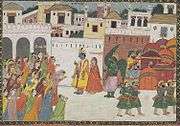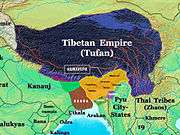Pragjyotishpura
Pragjyotishpura (Pron: prāgˈʤjəʊtɪʃˌpʊərə), now deemed to be a region within modern Guwahati, was an ancient city and capital of the medieval Kamarupa Kingdom under Varman dynasty (350 - 650 A.D).[1] The earliest mention from local sources come from the 7th century.[2]
%2C_Kamarupa_-_Panel_on_Plinth.jpg)

Etymology
The Pragjyotishpura is derived from Sanskrit. Prag means former or eastern and 'jyotisha' a 'star', 'astrology', 'shining', 'pura' a city thus meaning ' city of eastern light ' otherwise 'city of eastern astrology'.[3]

Location of Pragjyotishpura
According to the epic Ramayana, Pragjyotishpura city was built on Varāha mountain. No inscription up to the 12th century, when the kingdom of Kamarupa came to an end, give an indication of the location of Pragjyotisha,[4] and the exact location is not known. Three late medieval inscriptions seem to suggest that Pragjyotishpura included the Ganeshguri (inscription from Dununtarai, 1577)[5], Southern slope of Nilachal hills (inscription from Dihingiya Borphukan 1732) and Navagraha temple (inscription Tarun Duara Borphukan, 1752).[6] There are various other theories that modern historians have put forward,[7] but none of them are backed by archaeological evidence. The location of a temple of planet worship called Navagraha, meaning abode of nine planets of the solar system, and its connection with ancient research on astronomy and astrology lends weight to the origin of its name.[8]
See also
Notes
- Chaudhury, P. D. (2010). Archaeology in Assam: An Introduction. Directorate of Archaeology, Assam. p. 17.
- "The earliest mention of the name of Pragjyotisa in the local sources has been found only in the 7th century onwards." (Boruah 2003:339)
- Indian History Congress (1960). Proceedings, Indian History Congress. Indian History Congress. p. 43.
- (Boruah 2003:342)
- Neog, Maheswar, Prachaya Sansanavali,p. 16, The inscription is dated to 1499 Saka(1577 AD)
- (Boruah 2003:342–343)
- (Borauh 2003:343)
- Sonalker, Manoher V. (2007). India: The Giant Awakens!. Atlantic Publishers & Dist. p. 159.
References
- Sen, Debasis (1984). "Ethnic Elements in the Political Life of Ancient Assam". Proceedings of the Indian History Congress. 45: 101–106. JSTOR 44140186.
- Boruah, Nirode (2003). "Pragjyotisapura: The Capital City of Early Assam". Proceedings of the Indian Historical Congress. 64: 337–347. JSTOR 44145474.